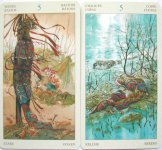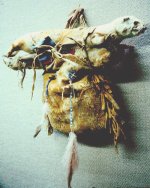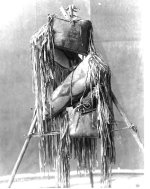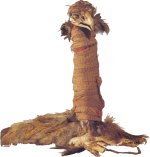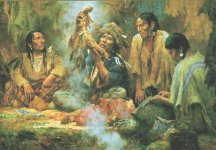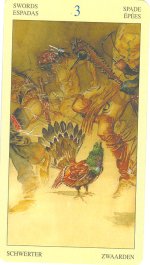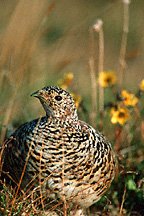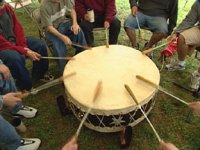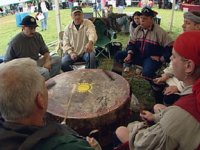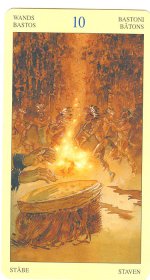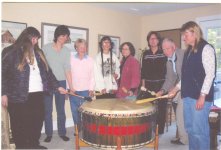Medicine Bundles
2 of the cards show the same Medicine Bundle; a traditional Otter Bundle.
I already mentioned the 5 of Chalices as showing Nigig / Long Otter, Keeper of the flow of life and Guardian of the first degree of the Midewiwin Medicine Society of the Ojibwa....
To me this Card symbolizes Nigig's Power and the all-present inter-connectedness of everything everywhere.
On the 5 of Wands the Bundle is staked in front of the healer's lodge and in the backround we see him attending to a patient. To me that card therefor is the card of the Healer and of Healing Power.
Here is a little bit about Medicine Bundles:
Before talking about medicine bundles, I first will talk a little about "medicine."
Medicine to Native Americans means a type of spiritual guidance or special power. People gained their medicine through visions. Anything of great power could be said to be the result of a certain medicine. Medicine bundles come in a wide variety of shapes and sizes, but generally they are made up of sacred objects wrapped in a cover. The covers were usually made by women. It is an honour to be asked to make a bundle cover, and is thought to bring good luck to the maker. The cover is made according the instructions of a whoever had a vision. The cover can be made from a wide variety of materials, including deer skin, buffalo hide, or the skins of animals such as weasels, turned inside out.
The covers may be decorated with symbols and colours, the significance of which may only be known to the visionary who is planning the bundle. In later times Teepee canvas or in the eastern woodlands canoe canvas was used as a cover material.
Medicine people keep their medicine tools in a medicine bundle. This is a large piece of cloth or hide that they tie securely with a thong, or a piece of yarn or string. The contents of the medicine bundle are sacred. Each medicine person may own or share in different medicine bundles: their own, the tribe's, and bundles for special purposes, like seeking visions, hunting, or protection in battle. Some are passed down from one generation to the next. Personal medicine bundles are private and asking about another person's medical tools is forbidden. Some are small enough to be worn around the neck. Medicine bundles belonging to tribes are often called the "grandmothers" because they have the power to nourish and nurture the tribe and promote continued well-being. Tribal medicine bundles grow stronger with each passing year.
One Winnebago medicine bundle contained: three paws of a black bear, a bone tube stuffed with small feather wrapped in the skin of an eagles head, enclosed in a pouch of otters skin containing a bunch of feathers, fastened at the mouth with a peace of eagles skin, two cane whistles, a paint bag, a moccasin with herbs inside, four snake skins, a white weasel skin, herbs, a cane whistle, a brown weasel skin, two snake vertebrae, a bone whistle, a cormorant head, a woodpecker head, a black squirrel skin, two small wooden dolls tied together, a dried eagle claw, animals eyes, a horse chestnut, teeth, a wooden bowl and spoon and eight woven pouches with dried herbs.
That leaves me to mention, that I myself am a Bundle Keeper.
A year and a half ago I was entrusted with an old family Bundle from a local family. The owner had suddenly died and all the relatives had turned to Christianity and wanted to burn "that Devil's Do"
A family friend knew that the deceased had high regard for my work and previously given me a "Medicine Gift" So she convinced the family members to pass the Bundle over, least they would be befallen by bad luck for tossing it away....
It contains ceremonial items reaching back from the 1880's Midewewin Medicine Society to items connected with the Peyote rituals of the Native American Church....
And believe you me: That Bundle is alive and a presence in our house with demands of its own....

